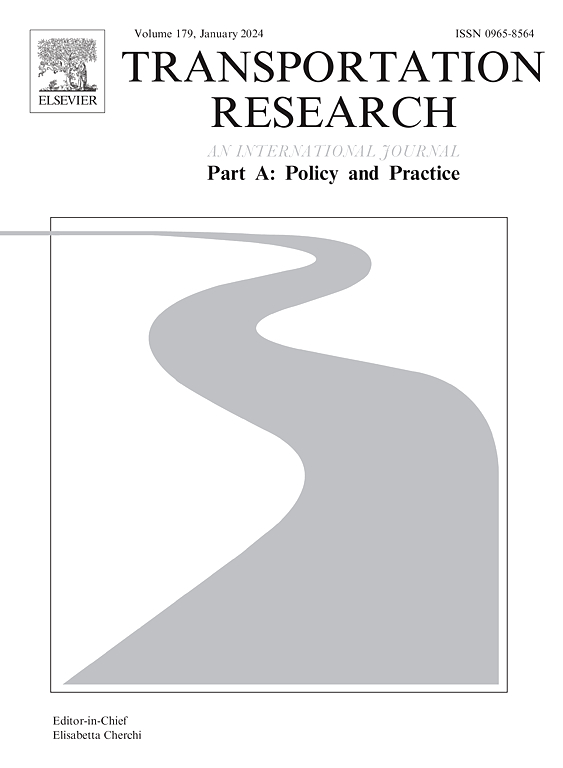不断变化的远程工作环境中的住房选择
IF 6.3
1区 工程技术
Q1 ECONOMICS
Transportation Research Part A-Policy and Practice
Pub Date : 2024-10-25
DOI:10.1016/j.tra.2024.104285
引用次数: 0
摘要
我们从几个方面对住房选择的联合模型进行了估算,以考虑到 COVID-19 大流行病导致的住房价值变化。我们考虑的住房结果包括住房类型、保有权类型、是否有庭院或院子、卧室数量、社区人口密度、住房成本中位数、设施便利性、学校质量、犯罪率和通勤距离。本分析所使用的数据是 2021 年 10 月和 11 月从全美 24 个大都会地区收集的。广义异质数据模型(GHDM)用于估算这些住房结果,将其作为外生家庭社会人口特征和潜在生活方式倾向的函数。广义异质性数据模型还能捕捉到未观察到的因素所导致的关联性,从而准确估算出结果之间的因果效应。结果显示,生活方式偏好对住房结果有显著影响。具体而言,偏好远程办公的个人更有可能居住在人口密集地区的单户住宅中,通勤距离更长,对社区内是否存在便利设施的敏感度更高。此外,对住房结果之间的权衡分析揭示了各种住房结果的相对价值。研究发现,通勤距离的增加会导致单户住宅的增加、密度的降低以及犯罪率的上升。在高密度社区选择公寓会导致学校质量下降和犯罪率显著上升。研究结果对土地使用规划、出行需求分析和公平考虑的影响得到了确认和讨论。本文章由计算机程序翻译,如有差异,请以英文原文为准。
Housing choice in an evolving remote work landscape
We estimate a joint model of housing choice along several dimensions to account for changing valuations of housing outcomes due to the COVID-19 pandemic. We consider housing outcomes including housing type, tenure type, the presence of a patio or yard, the number of bedrooms, neighborhood population density, median housing cost, accessibility of amenities, school quality, crime rate, and commute distance. Data used for this analysis were collected in October and November of 2021 from 24 metropolitan areas across the United States. A Generalized Heterogeneous Data Model (GHDM) is used to estimate these housing outcomes as a function of exogenous household sociodemographic characteristics and latent lifestyle propensities. The GHDM also captures jointness caused by unobserved factors, allowing for the estimation of accurate causal effects between outcomes. The results reveal that lifestyle preferences have significant impacts on housing outcomes. Specifically, individuals with a preference for teleworking are more likely to reside in single-family homes in highly populated areas, experience longer commute distances, and exhibit a higher sensitivity to the presence of amenities in their neighborhoods. Additionally, the analysis of tradeoffs between housing outcomes reveals the relative valuations of various housing outcomes. An increased commute distance is found to lead to an increase in single-family homes, reductions in density, and an increased crime rate. Choosing an apartment in a high-density neighborhood is found to lead to reductions in school quality and significant increases in crime rates. Implications of the results for land-use planning, travel demand analysis, and equity considerations are identified and discussed.
求助全文
通过发布文献求助,成功后即可免费获取论文全文。
去求助
来源期刊
CiteScore
13.20
自引率
7.80%
发文量
257
审稿时长
9.8 months
期刊介绍:
Transportation Research: Part A contains papers of general interest in all passenger and freight transportation modes: policy analysis, formulation and evaluation; planning; interaction with the political, socioeconomic and physical environment; design, management and evaluation of transportation systems. Topics are approached from any discipline or perspective: economics, engineering, sociology, psychology, etc. Case studies, survey and expository papers are included, as are articles which contribute to unification of the field, or to an understanding of the comparative aspects of different systems. Papers which assess the scope for technological innovation within a social or political framework are also published. The journal is international, and places equal emphasis on the problems of industrialized and non-industrialized regions.
Part A''s aims and scope are complementary to Transportation Research Part B: Methodological, Part C: Emerging Technologies and Part D: Transport and Environment. Part E: Logistics and Transportation Review. Part F: Traffic Psychology and Behaviour. The complete set forms the most cohesive and comprehensive reference of current research in transportation science.

 求助内容:
求助内容: 应助结果提醒方式:
应助结果提醒方式:


